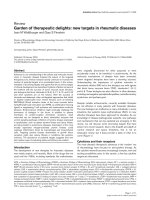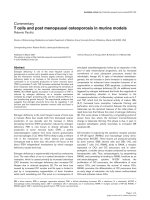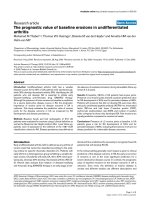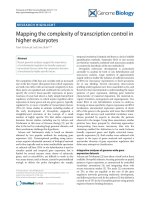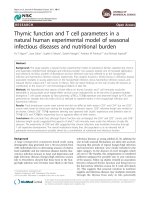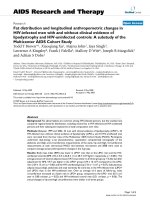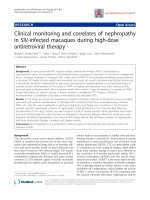Báo cáo y học: " Fat tissue and adiponectin: new players in critical care" docx
Bạn đang xem bản rút gọn của tài liệu. Xem và tải ngay bản đầy đủ của tài liệu tại đây (43.87 KB, 2 trang )
Available online />Page 1 of 2
(page number not for citation purposes)
Abstract
Historically, adipose tissue was thought to be a passive tissue that
stores energy and protects the body from temperature and injury.
In contrast to this concept, it is now evident that adipose tissue is
an active endocrine organ secreting many kinds of adipocytokines,
including adiponectin. Presumably, adipose tissue and its products
may have some impact on numerous pathways of response to
trauma, sepsis and stress. The discussion on a plausible role of
adiponectin in critical illness has been raised by the fact of finding
hypoadiponectinemia in critically ill patients. The nature of this
phenomenon, however, remains to be elucidated, and noteworthy
clinical studies should prompt further efforts in basic research to
explain the mechanisms beyond the clinical observation of low
adiponectin levels in humans with severe illness.
In the current issue of Critical Care, Venkatesh and
colleagues present a novel study on adiponectin in critical
illness [1]. This article, along with the concept of adipose
tissue and adipocytokines being involved in the mechanisms
of critical illness, requires some commentary.
Historically, adipose tissue was thought to be an inert tissue
that stores energy and protects the body from temperature
and injury. In contrast to this concept, it is now evident that
adipose tissue is an active endocrine organ secreting many
kinds of adipocytokines – such as adiponectin, leptin, IL-6,
and TNFα – that may affect metabolism, body weight
regulation, and glucose and lipid homeostasis [2]. Produced
exclusively in the adipose tissue, adiponectin is the most
abundant adipocytokine and circulates in the blood at high
concentrations, accounting for approximately 0.01% of the
total plasma protein [3-5]. Studies in rodents demonstrate a
role for adiponectin in obesity and insulin resistance [6,7]. In
humans, reduced serum levels of adiponectin in obese
subjects compared with nonobese subjects and negative
correlations between adiponectin and body mass index (BMI)
have, and have not, been reported [8-10]. Furthermore,
serum concentrations of adiponectin have been found to be
inversely correlated with insulin resistance in both nonobese
and obese subjects and in patients with type 2 diabetes
mellitus [11-13].
In spite of numerous clinical studies on adiponectin, however,
its exact role in metabolism is unclear and remains to be
elucidated, along with the as yet unsolved adiponectin
paradox: a decreased concentration of adiponectin in obesity
seems paradoxical, since fat tissue is the only known source
of this protein. In viuew of that, the paper by Venkatesh and
colleagues broadens knowledge of the subject and links the
function of adipose tissue to the general defense against
critical illness [1]. The authors’ suggestion that adiponectin
may play a part in the inflammatory response in patients with
critical illness is interesting, but it should be considered
bearing in mind some limitations of the study. Perhaps the
major limitation is the lack of data on patients’ BMI.
Associations between low and high BMI and mortality are
well known, as are the correlations between BMI and
adiponectin. Different BMI values between groups could
consequently have influenced the adiponectin results. Under
these circumstances, the final results should be interpreted
cautiously.
Furthermore, the associations between serum cortisol and
adiponectin in critical care patients demonstrated in this
study also require comment. The high standard deviation for
cortisol might have been caused by adrenal insufficiency in
several patients with very low cortisol levels. In this setting,
the group is not homogeneous with respect to adrenal
response to stress, and consequently the overall statistical
result may be confusing. Still, the authors have raised an
interesting problem regarding the link between adrenal
function and adipose tissue metabolism in critical illness. An
increased secretion of glucocorticoids by the adrenal gland is
Commentary
Fat tissue and adiponectin: new players in critical care?
Maciej Owecki
Department of Endocrinology, Metabolism and Internal Medicine, University of Medical Sciences in Poznan´, ul. Przybyszewskiego 49,
60-355 Poznan´, Poland
Corresponding author: Maciej Owecki,
Published: 5 August 2009 Critical Care 2009, 13:174 (doi:10.1186/cc7974)
This article is online at />© 2009 BioMed Central Ltd
See related research by Venkatesh et al., />BMI = body mass index; IL= interleukin; TNF = tumor necrosis factor.
Critical Care Vol 13 No 4 Owecki
Page 2 of 2
(page number not for citation purposes)
a well-known defense mechanism against hypotension and
stress, whereas a decreased cortisol concentration is
associated with a worse prognosis. On the basis of this
article, therefore, one can propose the hypothesis that a
decreased adrenal response presumably inhibits protective
adiponectin secretion, thus deteriorating the overall clinical
condition. Obviously, in face of the above-mentioned study
limitations, this tempting hypothesis requires further research.
Although based on a preliminary study only, the idea shown
by Venkatesh and colleagues generates new hypotheses –
meaning we should have a rethink of the role of fat tissue in
the critical state in humans. Obviously the authors did not
investigate the mechanism of decreased adiponectin in
critical illness, as it was not the aim of their study. However,
the following fact is now evident: being a complicated organ
and being spread throughout the body hormone-producing
and cytokine-producing machinery, adipose tissue cannot
stand passively by in the face of severe threat to life, and is
involved in numerous inflammatory responses including
production of adipocytokines, TNFs, and metabolites of fat
catabolism. The nature of these responses remains to be
elucidated, however, and noteworthy clinical studies should
prompt further efforts in basic research to explain the
mechanisms beyond clinical observations.
Competing interests
The author declares that they have no competing interests.
References
1. Venkatesh B, Hickman I, Nisbett J, Cohen J, Prins J: Changes in
serum adiponectin concentrations in critical illness: a prelimi-
nary investigation. Crit Care 2009, 13:R105.
2. Friedman JM: Obesity in the new millennium. Nature 2000, 404:
632-634.
3. Scherer PE, Williams S, Fogliano M, Baldini G, Lodish HF: A
novel serum protein similar to C1q, produced exclusively in
adipocytes. J Biol Chem 1995, 270:26746-26749.
4. Fruebis J, Tsao TS, Javorschi S, Ebbets-Reed D, Erickson MR,
Yen FT, Bihain BE, Lodish HF: Proteolytic cleavage product of
30-kDa adipocyte complement-related protein increases fatty
acid oxidation in muscle and causes weight loss in mice. Proc
Natl Acad Sci USA 2001, 98:2005-2010.
5. Berg AH, Combs TP, Scherer PE: ACRP30/adiponectin: an
adipokine regulating glucose and lipid metabolism. Trends
Endocrinol Metab 2002, 13:84-89.
6. Kubota N, Terauchi Y, Yamauchi T, Kubota T, Moroi M, Matsui J,
Eto K, Yamashita T, Kamon J, Satoh H, Yano W, Froguel P, Nagai
R, Kimura S, Kadowaki T, Noda T: Disruption of adiponectin
causes insulin resistance and neointimal formation. J Biol
Chem 2002, 277:25863-25866.
7. Berg AH, Combs TP, Du X, Brownlee M, Scherer PE: The
adipocyte-secreted protein Acrp30 enhances hepatic insulin
action. Nat Med 2001, 7:947-953.
8. Arita Y, Kihara S, Ouchi N, Takahashi M, Maeda K, Miyagawa J,
Hotta K, Shimomura I, Nakamura T, Miyaoka K, Kuriyama H,
Nishida M, Yamashita S, Okubo K, Matsubara K, Muraguchi M,
Ohmoto Y, Funahashi T, Matsuzawa Y: Paradoxical decrease of
an adipose-specific protein, adiponectin, in obesity. Biochem
Biophys Res Commun 1999, 257:79-83.
9. Staiger H, Tschritter O, Machann J, Thamer C, Fritsche A, Maerker
E, Schick F, Haring HU, Stumvoll M: Relationship of serum
adiponectin and leptin concentrations with body fat distribu-
tion in humans. Obes Res 2003, 11:368-372.
10. Owecki M, Miczke A, Pupek-Musialik D, Bryl W, Cymerys M,
Nikisch E, Sowin´ski J: Circulating serum adiponectin concen-
trations do not differ between obese and non-obese Cau-
casians and are unrelated to insulin sensitivity. Horm Metab
Res 2007, 39:25-30.
11. Pellme F, Smith U, Funahashi T, Matsuzawa Y, Brekke H, Wiklund
O, Taskinen MR, Jansson PA: Circulating adiponectin levels are
reduced in nonobese but insulin-resistant first-degree rela-
tives of type 2 diabetic patients. Diabetes 2003, 52:1182-1186.
12. Weyer C, Funahashi T, Tanaka S, Hotta K, Matsuzawa Y, Pratley
RE, Tataranni PA: Hypoadiponectinemia in obesity and type 2
diabetes: close association with insulin resistance and hyper-
insulinemia. J Clin Endocrinol Metab 2001, 86:1930-1935.
13. Kern PA, Di Gregorio GB, Lu T, Rassouli N, Ranganathan G:
Adiponectin expression from human adipose tissue: relation
to obesity, insulin resistance, and tumor necrosis factor
expression. Diabetes 2003,
52:1779-1785.


